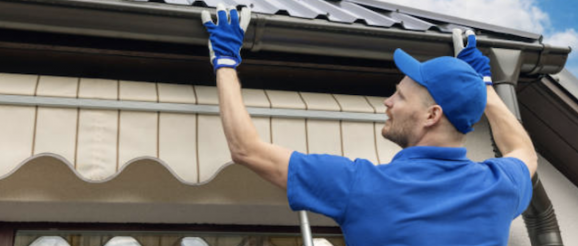What is Gutter Pitch?

All gutters are fastened at a slight angle so water drains out of them instead of sitting stagnant. Gutters don’t look slanted because installation pros know exactly what they’re doing, but they are.
Gutters have a specific slope based on this formula:
¼ of an inch of drop per 10 feet of gutter
This formula tells your gutter installation technician right where to fasten the downspout so that even heavy amounts of precipitation can flow unobstructed from your roof. The side of your roof where the downspouts are located is the side that should be lower.
Long areas of gutter, like across the front of a home, require a downspout on each side. When this is the case, the rain gutters will need to be pitched from the middle, which means that the center of the roofline will be the absolute highest point, and both downspouts should be lower than this middle point.
Gutter Pitch Problems
If your gutters are installed incorrectly or if they are loose or bent, it can lead to problems that might be expensive and complex to repair.
When your gutter pitch is wrong, it can cause water to back up in your gutters. Water is a common issue around the home, as it can lead to all of the following issues:
- Rain inside of the gutters can lead to roof damage due to the standing water. When water doesn’t flow from the gutters, water can get underneath the shingles and cause damage to the fascia, sub-roofing and even leak inside your home.
- Standing rain water is one way mildew and mold can grow on of your roof, gutters or siding. Getting rid of mold is a very hard task, especially when it grows on your roof. Mold is known for ruining organic materials (many of which exist in your home) and making people sick.
- The weight of pooling water in your rain gutters can cause them to tear away from your roof. The gutters can pull fasteners from the siding, damaging your vinyl or other exterior material. It can also ruin surrounding landscaping and windows.
Do You Have a Gutter Pitch Problem?
To be confident your gutters are correctly pitched, here are a few things you can do:
Look for Hanging Spots
As we mentioned before, you shouldn’t be able to see the slope of your rain gutters. If you can noticeably identify where the low spot is, it is an indication that your gutter is damaged or that it is getting old.
You should be able to notice a dip in the gutters from below, so this is a safe job that you can do on your own, with their feet on the ground.
Check for Standing Water
Water follows the path of least resistance, so any amount of water inside of your home’s gutters is an issue. Try to inspect the gutters immediately after rainfall so you can see the flow of the water.
This might force you to climb a ladder, so exercise caution. If you aren’t comfortable doing this, you can have a handyman or a gutter specialist from Better Baltimore Gutters do it for you.
Inspect for Shingle Particles
Any small granules left behind in the gutters from your shingles means the gutters may not have enough slope, so the water can’t carry these heavier materials out. Seeing grit or sludge in your gutters is common after having a new roof installed because it will tend to lose excess granules in the first few years.
You can climb up a ladder and take a look, or you might see some of the particles making their way out of your gutters through the downspouts. If you notice a small amount in these areas, chances are there is more that is unable to make its way out.
Why is There Overflow?
Gutter overflow is usually caused by a blockage, but it can also be due to incorrect gutter pitch. If rain water is flowing in the wrong direction, know as “back pitch,” you will probably see water overflowing from the end cap. This can cause damage to your roof, gutters and landscaping.
To stop the possibility of a blockage, schedule gutter cleaning at least once a year or install gutter guards. If the gutters are clean but there are still signs of overflow, it’s another indicator that there is a gutter pitch problem.
Professional Gutter Damage Repair
If your gutter pitch gets distorted, it can result in many problems for your house. All of the issues above can let you determine if your gutter pitch is not right.
No matter if your rain gutters were damaged or they were installed poorly in the first place, they need to be re-pitched in order to avoid major home repairs, including damage to siding, leaks and landscape damage.
Gutter Repair in Baltimore
The most affordable option will be repairing the existing gutters so the correct pitch is restored. If the gutters are in prime condition and undamaged, this will be the route Better Baltimore Gutters encourages.
To restore gutter pitch, Better Baltimore Gutters will loosen the gutter, but they won’t need to take it completely down. This lowers labor costs and time. Then the technician will measure and calculate the pitch needed and reinstall the gutters, adjusting fasteners if necessary, to fit the specific measurements.
Gutter Installation in Baltimore
If your gutters are permanently damaged, or if they are rusting or wearing down with age, Better Baltimore Gutters may recommend to replace them instead of re-pitching them. This can be more economical over time and time-saving.
If your gutters need to be replaced, they will include new fasteners, hardware and downspouts. The installer should set the gutters at the correct pitch. You can use our tips in this blog post to make sure the new installation was done correctly.
